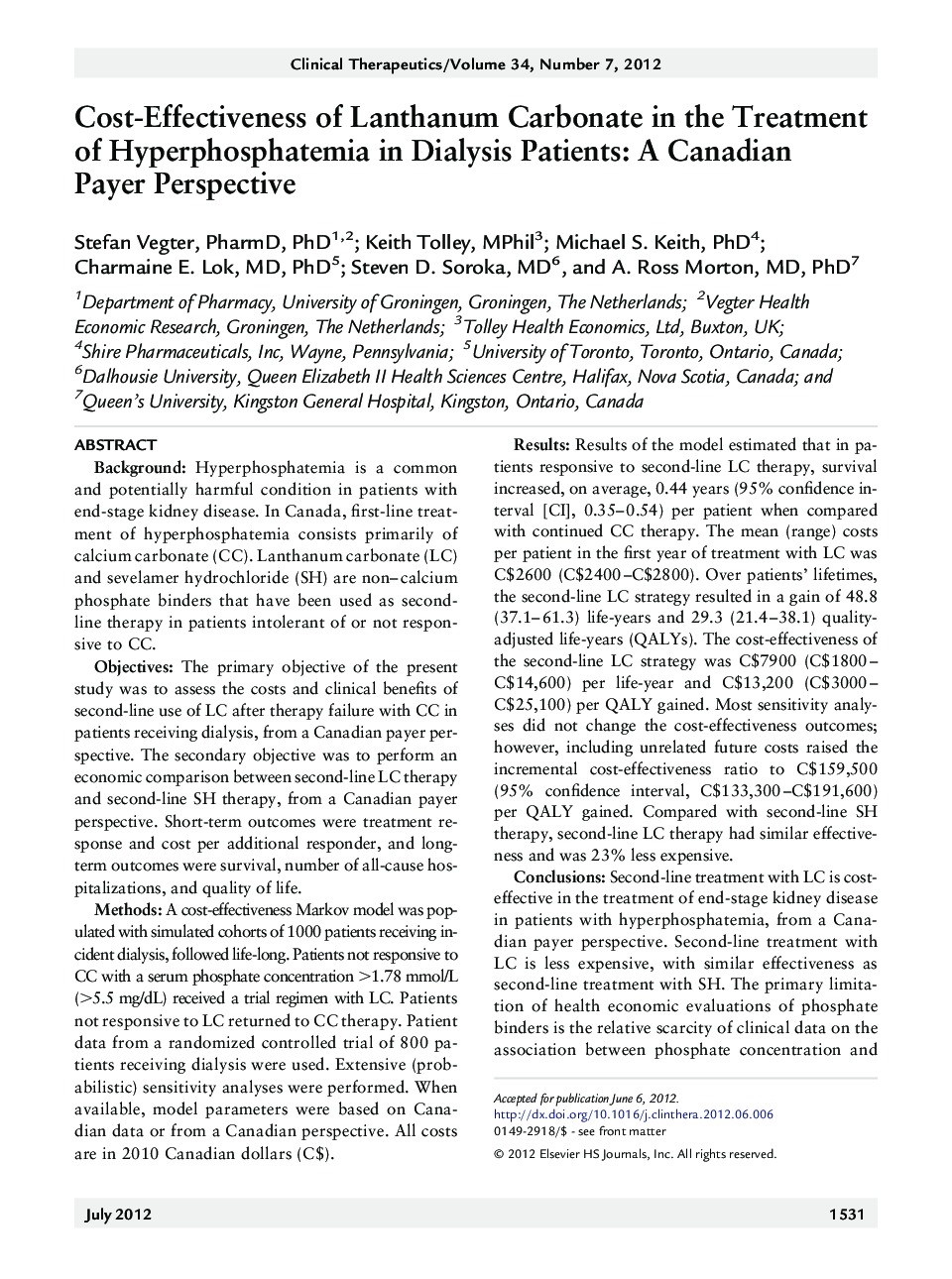| کد مقاله | کد نشریه | سال انتشار | مقاله انگلیسی | نسخه تمام متن |
|---|---|---|---|---|
| 2527163 | 1119901 | 2012 | 13 صفحه PDF | دانلود رایگان |

BackgroundHyperphosphatemia is a common and potentially harmful condition in patients with end-stage kidney disease. In Canada, first-line treatment of hyperphosphatemia consists primarily of calcium carbonate (CC). Lanthanum carbonate (LC) and sevelamer hydrochloride (SH) are non–calcium phosphate binders that have been used as second-line therapy in patients intolerant of or not responsive to CC.ObjectivesThe primary objective of the present study was to assess the costs and clinical benefits of second-line use of LC after therapy failure with CC in patients receiving dialysis, from a Canadian payer perspective. The secondary objective was to perform an economic comparison between second-line LC therapy and second-line SH therapy, from a Canadian payer perspective. Short-term outcomes were treatment response and cost per additional responder, and long-term outcomes were survival, number of all-cause hospitalizations, and quality of life.MethodsA cost-effectiveness Markov model was populated with simulated cohorts of 1000 patients receiving incident dialysis, followed life-long. Patients not responsive to CC with a serum phosphate concentration >1.78 mmol/L (>5.5 mg/dL) received a trial regimen with LC. Patients not responsive to LC returned to CC therapy. Patient data from a randomized controlled trial of 800 patients receiving dialysis were used. Extensive (probabilistic) sensitivity analyses were performed. When available, model parameters were based on Canadian data or from a Canadian perspective. All costs are in 2010 Canadian dollars (C$).ResultsResults of the model estimated that in patients responsive to second-line LC therapy, survival increased, on average, 0.44 years (95% confidence interval [CI], 0.35–0.54) per patient when compared with continued CC therapy. The mean (range) costs per patient in the first year of treatment with LC was C$2600 (C$2400–C$2800). Over patients' lifetimes, the second-line LC strategy resulted in a gain of 48.8 (37.1–61.3) life-years and 29.3 (21.4–38.1) quality-adjusted life-years (QALYs). The cost-effectiveness of the second-line LC strategy was C$7900 (C$1800–C$14,600) per life-year and C$13,200 (C$3000–C$25,100) per QALY gained. Most sensitivity analyses did not change the cost-effectiveness outcomes; however, including unrelated future costs raised the incremental cost-effectiveness ratio to C$159,500 (95% confidence interval, C$133,300–C$191,600) per QALY gained. Compared with second-line SH therapy, second-line LC therapy had similar effectiveness and was 23% less expensive.ConclusionsSecond-line treatment with LC is cost-effective in the treatment of end-stage kidney disease in patients with hyperphosphatemia, from a Canadian payer perspective. Second-line treatment with LC is less expensive, with similar effectiveness as second-line treatment with SH. The primary limitation of health economic evaluations of phosphate binders is the relative scarcity of clinical data on the association between phosphate concentration and long-term outcome.
Journal: Clinical Therapeutics - Volume 34, Issue 7, July 2012, Pages 1531–1543